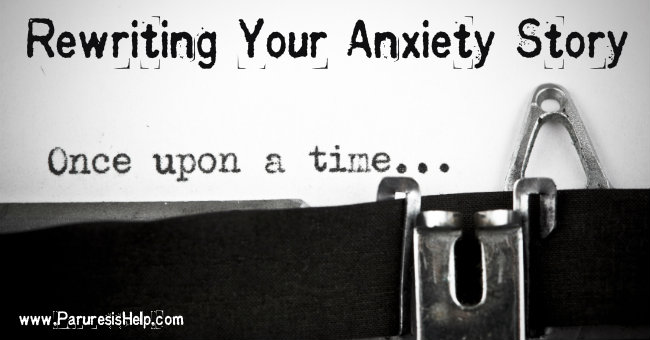
This article is part three of a three-part blog series on How You Can Escape the Anxiety Story. Click here to read the rest of the series.
People are great at making up stories. Those stories can amuse, delight and push imagination to its wildest brink. Or those stories can turn a perfectly fine day or situation into one riddled with anxiety. While this trait can be awesome for writing tragic fiction, it may not be as useful when we do it every day. Misusing the imagination to generate worry and woe creates what I like to call our “Anxiety Story.”
This series of articles will not only define the Anxiety Story, but it will illustrate how you create it out of thin air, feed it, and replay it until it becomes an automatic habit. Once the habit becomes engrained enough, we’ll point out how you may start to avoid things that you may actually need to do in your daily life or other things that could otherwise be beneficial.
But we’re not going to leave you wallowing in this worry and woe. We will then show you how to stop creating the Anxiety Story before it begins to erode your life. We’ll top it all off with ways to continue to keep your Anxiety Story at bay and come back to that useful thing called reality.
Let’s start with illustrating how you create an Anxiety Story out of thin air.
Creating the Anxiety Story
In any situation, there are countless things we could choose to pay attention to and focus on, and limitless ways we could interpret those things. If you go to a party, there’s some people that love all the chitchat and social interaction, some that are nervous because they feel like they have nothing interesting to say, and others that are somewhere in the middle.
They are all at the exact same party but their experience of it is entirely different because of the particular story they are used to telling themselves about it.
Our stories become habitual because they get repeated and we begin to label them as “true” when that usually isn’t the case. A party isn’t “boring” or “fun” because it’s not boring or fun for everyone. It’s only boring or fun based on interpretations and internal stories. Roller coasters aren’t exciting or scary, they’re just roller coasters. A painting isn’t beautiful or hideous, it’s just a painting.
All these emotions that stem from an inanimate object or situation are your subjective interpretation of things.
How we choose to interpret our reality determines how we feel about and react to our experiences. It’s not always or even usually based on truth. Let’s say you have plans to meet a friend for lunch at noon. You arrive at the restaurant a few minutes before and sit down to wait. After awhile, you look at your watch and it’s 12:20.
That’s the reality.
You imagine that she’s sitting around her office chatting with her coworkers and being completely inconsiderate of your time and her commitment to meeting you when she said she would. What a lousy friend.
That’s the interpretation.
You get angrier and angrier as you watch the second hand tick on the clock across the room and you think of all the other ways this crummy friend has disappointed you and been selfish before. Maybe you should just leave; she’s not someone worth spending your lunch hour with anyway. Suddenly you see her through the window as she walks up to the door of the restaurant and wave at you. What a bitch.
That’s the reaction.
That’s one way it can go down. Here’s another.
Same day, same plans to meet a friend for lunch at noon. You arrive at the restaurant a few minutes before and sit down to wait. After awhile, you look at your watch and it’s 12:20.
That’s still the reality; it’s no different so far.
You hear an ambulance siren in the distance and you imagine her having gotten into a car accident and being hurt, all because you invited her to lunch to talk about a problem you’re having at work. She’s such a good friend.
That’s the interpretation.
You get more and more frantic as you watch the second hand tick on the clock across the room and you think of all the other ways this amazing friend has been kind enough to listen and be supportive before. Maybe you should call the hospital; she may need plasma. Suddenly you see her through the window as she walks up to the door of the restaurant and wave at you. Thank heavens she’s OK!
So what was she doing? What made her late? We have no idea, and that’s the point. The reality never changed, but the lens we viewed reality through made us have two completely different reactions to the exact same thing. One reaction turned you into a resentful mess while the other made you a very grateful friend. The stories you get used to telling yourself about the world around you dictate how you feel.
Change the story; change the feeling.
When we repeat the story often enough, it becomes a habit, a pattern that is repeated until it becomes virtually involuntary.
Before long, you start to tell yourself that a party will be boring before you even get there to find out. Likewise, you decide Monday’s business meetings at work are the pits before you even show up for them. The more often you tell yourself the story, the more “true” it feels and the harder it is to see things another way or give any other story a chance.
Your habitual story predetermines your results. You act bored and uncomfortable at the party because that’s how your story plays out, and because of that people avoid talking to you and, when they do, you don’t seem friendly or have anything interesting to say. So what happens? What a surprise – you do end up being bored. Maybe the same thing is happening at work.
Business meetings are boring, you say, so you decide to doodle during on your notepad, constantly watch the clock, or otherwise not pay attention. When you boss asks for your take on what’s being discussed, you have no clue what the topic was and feel stupid and ashamed. Maybe your coworkers start to whisper. Now the business meeting is not only boring, but it’s treacherous!
But none of it has to be that way. These scenarios are your stories. You don’t have to run the same script every time; you are just used to running a specific tale on auto-pilot. The first step in stopping it is realizing what’s happening.
When you get anxious, try to figure out what the story is that you’re telling yourself. There’s always another and better way to look at it. Especially with anxiety, your story has multiple chapters that are linked together.
The anxiety chain reaction
The chapters feed on each other and work together to create a volatile chain reaction that goes something like this:
- You tell yourself that a situation is going to make you anxious.
- You tell yourself that being anxious means your heart is going to race.
- You tell yourself that a racing heart means you’re going to lose control or embarrass yourself or that it will get worse.
- You tell yourself that to prevent those things you need to escape or avoid it altogether.
- The next thing you know, you’re no longer going to any parties, you hide in the bathroom during business meetings or you start calling in sick to work every Monday.
You need some new stories.
Exercise: Identify the Anxiety Story
The next time you start to feel anxious in a given situation or have a predetermined notion about a party, a business meeting or other event, step back and ask yourself a few questions.
- What’s your Anxiety Story?
- What are the chapters?
- Is the story true? Does it have to be true? Does it have to be true forever?
- What story would you rather have? Is the new story any less true?
Write down both stories so you can better evaluate them.
Our next article dives deeper into the Anxiety Story, noting how it becomes entrenched in our lives and why you continue to replay it. Read on!
This article is part three of a three-part blog series on How You Can Escape the Anxiety Story. Click here to read the rest of the series.




